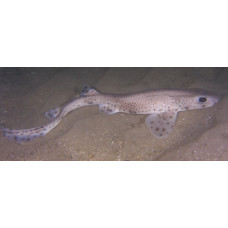Latin name
Scyliorhinus canicula
Other name
Sandy dogfish, lesser-spotted dogfish, rough-hound or morgay.
Identification
The nostrils of the small-spotted catshark are covered by wide flaps separated by a narrow gap. The inner nasal flap on the outer edge of the nostril is pointed. Their skin is coarse and resembles sandpaper. Males have larger teeth than females. The jaws of male sharks in East African waters are strong and large, likely due to their diet and mating behavior.
Features of fish fins
These sharks have long, low caudal fins, underdeveloped lower blades, and dorsal fins located in the posterior half of their bodies. The first dorsal fin begins behind the pelvic fin base. The first dorsal fin is larger than the second.
Fish colouring
The Small-spotted Catshark has a sandy brown back and sides with dark brown spots. Its ventral side is light gray.
Distribution
This species is found throughout the Atlantic coast of Europe, from the Shetland Islands and Norway in the north to Senegal and possibly Côte d'Ivoire in the south. It is also found in the Mediterranean Sea and the Marmara Sea. In the Black Sea, it is occasionally observed off the coast of Turkey. Nursery areas are present off the coasts of Livorno and Tuscany. The largest concentration of immature common catsharks is found at the edge of the continental shelf off the west coast of Morocco.
Habitat
It inhabits the bottom at depths ranging from 10 to 780 meters, typically between 80 and 100 meters. It inhabits sandy, gravelly, and muddy bottoms. In the Mediterranean Sea, large concentrations of immature sharks are found on the upper continental slope at depths of about 200 meters, particularly off the coasts of northeastern Corsica and northeastern Sardinia, which are likely natural nurseries.
Size
The small-spotted catshark usually does not exceed 60-70 cm in length, though some individuals can grow up to 1 m. Its maximum weight is over 2 kg. Their maximum life expectancy is estimated at 12 years.
Behavior
These sharks are distributed throughout the water column according to their size. As they mature, they move closer to the shore, and mature individuals return to the edge of the continental shelf to breed. They are nocturnal. During the day, males rest on the ocean floor, while females hide in shallow-water shelters.
Food and feeding habits
They feed mainly on a variety of benthic invertebrates, such as crustaceans (crabs and shrimp), echinoderms, mollusks (mainly gastropods), polychaete worms, sipunculids, and tunicates. However, the basis of their diet is ten-legged crayfish and fish. Their food preferences change with age. Young sharks prey on small crustaceans, while adults eat more hermit crabs and mollusks. In the summer, when food is more abundant, sharks feed more intensely.
Reproduction
These sharks reproduce by laying eggs. Spawning occurs year-round, though it is seasonal for sharks from different geographic populations. For instance, on the Mediterranean coast of France, females lay eggs from March to June and in December. In British waters, spawning begins in spring and continues through July, followed by a break from August to October. Off the coast of Tunisia, the breeding season starts in the spring, peaks in the summer, and drops in August. The female lays two to twenty eggs, each of which is enclosed in a hard, horny capsule called a "mermaid's purse." These capsules are 4 to 6 cm long and 2 cm wide. The rounded corners of the capsule have long, thin, horny filaments that attach the capsule to the ground, algae, or other fixed objects. Embryo development lasts from five to 11 months, depending on the water temperature. Newborns are 9 to 10 centimeters long. Males and females reach sexual maturity at lengths of 37.1–48.8 cm and 36.4–46.6 cm, respectively.
Fishing
This shark is occasionally caught in large numbers as bycatch by commercial trawlers. Typically, the catch consists of individuals of the same sex. Sometimes, it is caught with a fishing rod. Most of the sharks caught are thrown back into the water, and the survival rate among released fish is very high—up to 98%.
Relationship with a person
This species of shark is harmless to humans. Its meat is edible, so local fishermen catch it in some places.
| Classification | |
| Phylum | Chordata |
| Class | Chondrichthyes |
| Squad | Carcharhiniformes |
| Family | Scyliorhinidae |
| Genus | Scyliorhinus |
| Species | S. canicula |
| Features | |
| Conservation status | Not Evaluated |
| Habitat | Bottom |
| Life span, years | 12 |
| Maximum body weight, kg | 2 |
| Maximum length, cm | 100 |
| Sailing speed, m/s | No information |
| Threat to people | Edible |
| Way of eating | Planktonophage |
Small-spotted catshark
Tags: small spotted catshark



